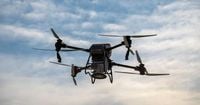Early on the morning of November 8, 2025, the quiet of Lidingö island, just outside Stockholm, was shattered by the whirring of a drone. Its target: the villa housing Russia’s trade delegation, a building that has become all too familiar with acts of protest and vandalism in recent months. According to multiple reports including Caliber.Az and statements from the Russian Embassy in Sweden, the drone swooped over the villa at around 5:30 a.m., dropping a container filled with red paint and an unknown sticky substance onto the building before making a swift getaway.
Police were quick to respond after the trade delegation staff, who witnessed the incident, alerted Stockholm regional authorities. Ola Osterling, press secretary for the Stockholm regional police, confirmed, “No one was hurt and the villa wasn’t evacuated.” Officers collected samples of the unidentified substance for laboratory analysis and opened a formal investigation into vandalism and harassment. As of now, the perpetrators remain unknown, and the drone itself was not recovered.
This was not an isolated event. In fact, it was the latest in a string of more than two dozen similar attacks targeting Russian diplomatic properties in Sweden since May 2024. The Russian Embassy has been vocal about the repeated acts of vandalism, sharing photographs on its Telegram channel that show red paint splattered across the pavement and the building’s entrance. The embassy’s terse statement on the matter—“No comments necessary”—speaks volumes about their mounting frustration.
These incidents have not gone unnoticed by Russian officials. According to MENAFN, Maria Zakharova, spokesperson for the Russian Foreign Ministry, has repeatedly called on Swedish authorities to bolster security for Russian diplomatic missions. In a recent statement, Zakharova warned, “Such provocations pose a threat not only to the diplomatic mission, but also to the city’s residents. Apparently, after Sweden joined NATO [in March 2024], it lost control over its internal and external security.” Zakharova’s remarks highlight the broader geopolitical tensions simmering beneath these acts of vandalism.
Lidingö island, the site of the most recent attack, is no ordinary neighborhood. It houses numerous foreign embassies, satellite offices, and diplomatic residences, making it a symbol of international presence in Sweden. The repeated targeting of the Russian trade delegation’s villa underscores the heightened security challenges facing diplomatic missions in Europe, particularly those associated with Russia since the intensification of the Ukraine conflict in 2022.
In the broader context, these attacks are part of a wave of vandalism and intimidation directed at Russian diplomatic establishments across Europe. Just last month, a woman was reportedly apprehended after allegedly threatening a police officer guarding the Russian Embassy in Berlin with a knife. Such incidents, while often non-lethal, have raised alarms about the safety of diplomatic personnel and the sanctity of international norms protecting foreign missions.
The use of drones in these attacks is especially notable. Drones, once the province of hobbyists and photographers, have become tools for protest and, occasionally, for more nefarious purposes. Their ability to bypass traditional security measures and deliver payloads—be it paint, sticky substances, or worse—has forced law enforcement agencies to rethink their approach to safeguarding sensitive sites.
Ola Osterling, speaking to Devdiscourse, emphasized the seriousness of the latest attack. “The trade delegation’s staff spotted the drone and saw it drop a container with the paint and unidentified substance around 5:30 am local time,” he said. Investigators are now analyzing the samples to determine the nature of the sticky substance, hoping it will provide clues about the perpetrators’ identities or motives.
For the Russian side, the attacks are more than mere vandalism—they are seen as provocations with potentially broader implications. Zakharova’s comments linking the incidents to Sweden’s NATO membership reflect Moscow’s anxieties about shifting alliances and perceived threats on its doorstep. “Apparently, after Sweden joined NATO [in March 2024], it lost control over its internal and external security,” she asserted, suggesting that the Swedish government’s promises to reinforce security have not translated into effective action on the ground.
Swedish authorities, for their part, have launched investigations and stepped up patrols, but the repeated success of the drone attacks points to the challenges they face. The anonymity afforded by drones, combined with the ease of acquiring and operating them, makes attribution and prevention a daunting task. The police have opened a case into vandalism and harassment, but as of now, no suspects have been identified.
The timing of these attacks is significant. They come as the war in Ukraine approaches its fourth anniversary in February 2026, a conflict that has claimed hundreds of thousands of lives and upended security dynamics across Europe. The ongoing hostilities have fueled anti-Russian sentiment in many countries, manifesting in protests, boycotts, and, increasingly, direct action against Russian properties abroad.
It’s worth noting that while the attacks have so far resulted in property damage and inconvenience, no injuries have been reported. The Russian trade delegation’s villa was not evacuated, and daily operations have continued, albeit under the shadow of persistent threats. Still, the psychological impact on staff and the broader diplomatic community cannot be underestimated. The sense of vulnerability is palpable, and the potential for escalation—should a future attack cause injury or worse—remains a concern.
The international community has long recognized the inviolability of diplomatic missions, enshrined in the Vienna Convention on Diplomatic Relations. Attacks on embassies and consulates, regardless of motive, are considered serious breaches of international law and can have far-reaching diplomatic repercussions. The Swedish government, aware of its obligations, has pledged to investigate thoroughly and ensure the safety of all diplomatic personnel on its soil.
Meanwhile, the Russian Embassy’s decision to share images of the aftermath and maintain a public record of the attacks serves both as a warning and a call for action. By documenting each incident, they hope to pressure Swedish authorities into taking more decisive measures and to rally international support against what they perceive as targeted harassment.
As the investigation unfolds, questions linger: Who is behind the drone attacks? Are they the work of individual activists, coordinated groups, or something more sinister? And, perhaps most importantly, what will it take to restore a sense of security to Stockholm’s diplomatic quarter?
For now, one thing is clear: the November 8 incident is unlikely to be the last. As tensions between Russia and the West persist and new technologies like drones become ever more accessible, the challenge of protecting diplomatic missions will only grow more complex. The world will be watching to see how Sweden responds—and whether it can prevent the next drone from making headlines.






